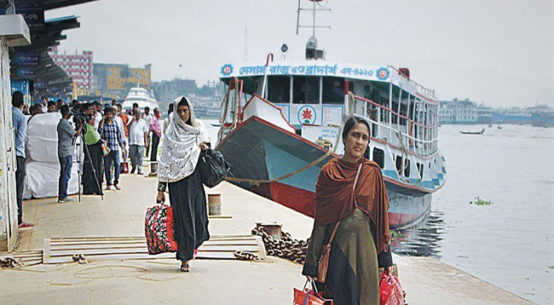In Dhaka, the capital of Bangladesh, the history of fire incidents stretches back decades, with each tragedy laying bare the systemic failures of monitoring and enforcement by the authorities.
The recurrence of these incidents, resulting in loss of lives and property, highlights a persistent cycle of negligence and a lack of proper supervision by the concerned agencies, including the Rajdhani Unnayan Kartripakkha (RAJUK) and the Fire Service and Civil Defence.
This pattern was tragically underscored by the recent blaze at a building housing several restaurants on Bailey Road, which claimed 46 lives, marking yet another dark chapter in Dhaka’s ongoing saga of preventable disasters.
The Bailey Road catastrophe is not an isolated incident but a continuation of Dhaka’s grim legacy of fire tragedies. Experts point to a systemic lack of accountability and supervision, with buildings across the capital flouting fire safety norms and regulations.
The construction of these structures often violates directives from the Fire Service and Civil Defence, lacking essential fire prevention measures such as alarms, adequate water supplies, and fire extinguishing systems.
The result is a cityscape riddled with potential fire traps, posing a constant threat to its inhabitants.
Professor Dr. Adil Muhammad Khan, President of the Bangladesh Institute of Planners (BIP), asserted that the frequent fires could be significantly reduced if the authorities took decisive action against those responsible for the lax approval and supervision of building constructions, and against building owners who neglect fire safety standards.
Dr. Khan emphasised that accountability must extend to RAJUK, the building owners, and even the tenants who, fully aware of the risks, continue to occupy these unsafe spaces.
The recurrence of fire incidents is further compounded by the failure to follow up on investigations after each tragedy. Dhaka has borne witness to several catastrophic fires, including those at Nimtoli, Churihatta, FR Tower, Armanitola, New Market, Moghbazar, and the latest disaster at Bailey Road. These incidents share common threads: mismanagement, the utilisation of risky multi-storied buildings, and a glaring lack of proper supervision, with many buildings operating without the requisite approvals from RAJUK and other regulatory bodies.
Despite repeated pledges from various quarters to transform Dhaka into a risk-free city, these promises have largely gone unfulfilled. Each tragic fire fades from public memory, only to be replaced by the next, in a seemingly endless cycle of devastation. This cycle is exacerbated by the mixed use of residential and commercial buildings, which Dr. Khan identified as a critical risk factor propelling the capital towards further disaster.
An example of this perilous overlap is the Green Cozy Cottage Building on Bailey Road. Despite approvals specifying that only the ground through fourth floors could be used commercially, with the fifth and sixth floors designated for residential purposes, the building predominantly housed restaurants, a clear breach of urban planning and building laws.
Dr. Khan advocated for treating such egregious violations, like the Bailey Road fire, as criminal acts, attributing them to the negligence of RAJUK and other service agencies.
The aftermath of the Bailey Road tragedy has seen calls for comprehensive measures, including the online registration of buildings with detailed usage information, and the public display of notices issued by the government against non-compliant building owners.
Ashraful Islam, the project director of the Detailed Area Plan (DAP) of RAJUK, clarified that the Bailey Road building was authorized only for office use, not for restaurants and showrooms, underscoring the illegal operations that contributed to the tragedy.
WHAT POLICE SAY
The police identified numerous restaurants operating within the building in violation of its approved use. Gas cylinders were stockpiled by the restaurants, highlighting a dangerous collusion between building owners and managers.
WHAT FIRE SERVICE AND CIVIL DEFENCE SAYS
Fire Service and Civil Defence Director General Brig Gen Md Moin Uddin noted the absence of fire extinguishing systems in the building, despite multiple notices issued to the owners, who disregarded these warnings.
WHAT RAJUK SAYS
Anisur Rahman Mia, chairman of RAJUK, stated that legal actions are underway against those implicated in the incident, with ongoing trials for previous fire-related cases. The establishment of a seven-member probe committee to investigate the Bailey Road fire, tasked with reporting their findings within seven working days, represents a step towards addressing these recurring tragedies. However, the broader challenge remains: ensuring compliance with RAJUK’s directives, a task complicated by the widespread disregard for regulatory standards, as evidenced by the failure of Mouchak Market authorities to respond to notices. The RAJUK chairman also claimed that nearly 70% of people did not follow their directives after getting approval for buildings.
A LOOK AT PREVIOUS FIRE TRAGEDIES IN DHAKA
Nimtoli
As many as 124 people were killed and 50 were injured as a transformer exploded at Nimtoli of Chankharpool on June 3, 2010. The fire department speculated that the fire was fanned by chemicals and other flammable products stored in shops. The overcrowded area also made it difficult for firefighters to bring the blaze under control


